[Guest Post] Peering In: Observations About Outsiders
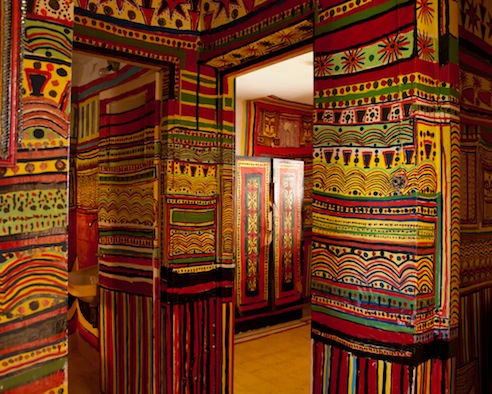
Afia Zecharia (1905-2000), 151 Nathan Elbaz Street, Shlomi
Photo: Shahar Amit, 2012
Guest post by Ophra Paul.
Ophra immigrated to Israel from the US 3 years ago. She is a graduate of the University of Maryland and an M.A. candidate at the Art History Department of the University of Haifa. She is currently writing her thesis on contemporary Israeli photography.
Exhibition: Art’s Outer Circles: Outsiders, Naive and Autodidacts
Venue: Haifa Museum of Art
Dates: Until July 20th, 2013
Peering In: Observations About Outsiders
“Lunatic,” was the comment I overheard an elderly woman say while viewing photographs and a video about Nissim Kahalon’s construction, “Paradise,” in the current exhibition at the Haifa Museum of Art, “Art’s Outer Circles: Outsiders, Naive and Autodidacts.” This is perhaps a natural reaction to art that was in fact made by people that are or have been institutionalized, live at the fringe of society or refuse to interact with society at all. However, this is a reaction to art that I have heard in hundreds of art museums all over the world, and in fact many famous artists have also been institutionalized and most artists do in fact live on the fringe of society.
So what is outsider art? “Art’s Outer Circles,” demonstrates many definitions and examples that help not only to explain what outsider art is, but also to raise questions about what it means to be an insider and what it means to be art.
The exhibition opens with a clear timeline to the history behind the terms “Outsider Art” and “Art Brut”, beginning in 1879 with the postman Ferdinand Cheval’s fabulous self constructed architectural masterpiece, Le Palais Ideal, to modern day museums and art collectors who celebrate art brut as a respectable genre of visual art. Interestingly, the timeline starts about 50 years after the camera was invented. This is an important turning point where the purpose of art began to be questioned by practitioners and consumers alike and the insulated “art world” as we know it was defined and cultivated. Before this point, “art for art’s sake” was not a discussion on the table; art was created for a purpose, for the church, the state, a rich patron but not the individual. Outsider art could not be accepted as an important phenomenon until the internal matters of the individual were recognized by society as worthy subjects for artistic expression.
The curator, Ruth Direktor, fit an impressive number of “artists” in the comprehensive exhibition, all of which are worth seeing and evaluating.
Among the most striking, was the work of Afia Zecharia. Unfortunately, you cannot see the original piece in person at the museum because her canvas was her home. Zecharia was a Yemenite woman with seven children, who moved to the town of Shlomi in Israel in 1950. She had been forbidden to paint the walls of her home by her husband when he was alive but when he died she proceeded to cover every inch of her apartment with bright abstract patterns interspersed with portraits. On the floors are dolls painted and dressed as Yemenite brides and miniature chickens at their feet. The exhibit offers a slide show tour of the home.
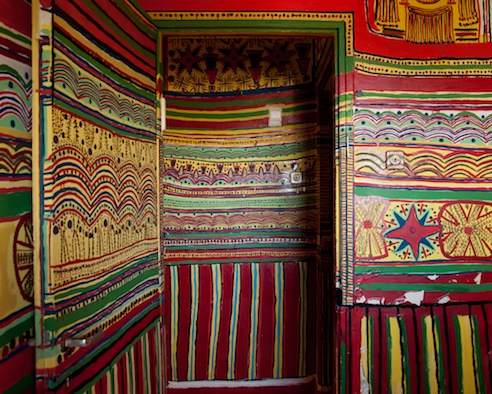
Afia Zecharia (1905-2000), 151 Nathan Elbaz Street, Shlomi
Photo: Shahar Amit, 2012
The compelling works based around religious texts by Ovadia Agassi, are captivating and original. Agassi was born in Bagdad and moved to Tel Aviv in 1950. He had an affinity for art his whole life but was discouraged by his family from pursuing it. Agassi lived a solitary life in Israel in a small one-bedroom apartment where he developed a relief technique with oils paints. The artist would squeeze tubes of white paint on the canvas in the shapes of letters and sometimes figures from Jewish religious texts, which he would let dry for months, before painting over them in rich vibrant colors. Even in the works that include figures, the text takes a primary role, crowding the canvas and asserting its significance.
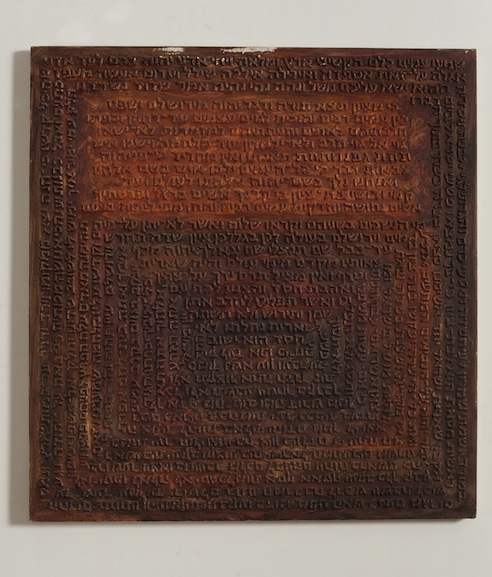
Ovadia Agassi (1920 – 1988), King David, triptych, ca. 1950-1970, Oil on canvas mounted on plywood
Private collection, Herzliya
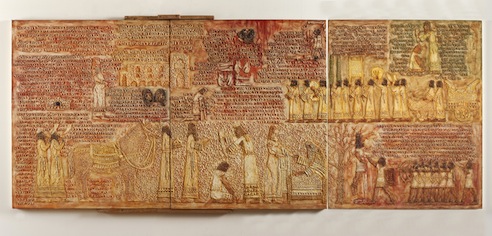
Ovadia Agassi (1920 – 1988), Micha’s Prophecy, ca. 1950-1970, Oil on canvas mounted on plywood
Private collection, Herzliya
There are also many international artists featured in the exhibition, including the unnerving, difficult and beautiful photography of Morton Bartlett. Bartlett was another solitary man, who never married. He was a freelance commercial photographer and the art dealer Marion Harris only discovered his personal collection after his death. She found 15 handcrafted dolls, 12 young girls and 3 boys, and over 200 posed photographs. Bartlett created outfits and sets for his dolls and posed them and photographed them, oftentimes innocently smiling, reading or crying and sometimes in naked erotic poses. His work is problematic, automatically drawing the viewer’s mind to pedophilia, but Bartlett was never accused of any crime and if the dolls were spun from inappropriate desires, as far as we know, they may have been a successful way to channel them. There is no doubt that the photographs are expertly framed and disturbingly fascinating.
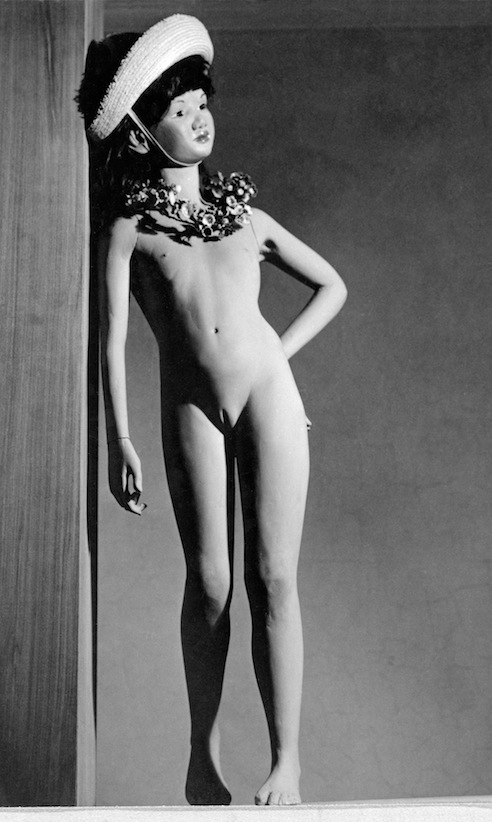
Morton Bartlett (1909 – 1992), Untitled (Polynesian girl), ca. 1950, Digital print, 2010
Courtesy Marion Harris Gallery, New York
Visual art is a significant way to convey a message, to transfer a thought. If visual art is a form of communication, then there needs to be a giver and a receiver, a creator and a viewer. Even if they never attended art school or took on the title “artist,” each of these individuals had ideas to share and found intricate and striking ways to express them. But there needs to be an audience who will listen, who will look, because if a person creates a work of art, but it is never seen, is it art?
The exhibit ends July 20th. Go see it before it closes and decide for yourself.
Text: Ophra Paul.